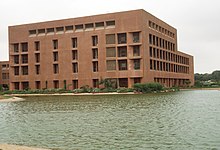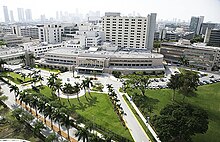Teaching hospital

A teaching hospital is a
Teaching hospitals use a
History
The first teaching hospital where students were authorized to methodically practice on patients under the supervision of physicians was reportedly the
Definitions
The following definitions are commonly used in connection with teaching hospitals:[9]
- Medical student–A person enrolled in a medical degree program at a medical school. In the graduate medical education model used in the United States, medical students must first complete an undergraduate degree from a university or college before being accepted to a medical school. In the undergraduate model traditionally used in countries such as the United Kingdom or Australia, medicine is an undergraduate university degree which students directly enter from high school. In more recent years, the graduate model has increasingly been adopted in the UK and Australia as well, without entirely displacing the traditional undergraduate model–both graduate entry and undergraduate entry programs coexist. (Historically, the undergraduate model used to exist in the US as well, but had been abandoned by the mid-19th century.)
- Physician assistant– Medical professionals who have completed training at the Masters level. They are trained to practice medicine alongside physicians on a population level allowing them to work in a wide range of specialties.[10] This profession is not traditionally found in most countries outside North America, but in recent years there have been attempts to establish it in some of them, with mixed success.
- Intern–A person that has a doctorate of medicine from a graduate medical school, or a Bachelor of Medicine/Bachelor of Surgery (in the British undergraduate model), that only practices with guidance and supervision of a physician/consultant.
- Residency or post-graduate program–In the US and Canada, individuals that have completed their first year of a medical internship. Residencies may last anywhere from two to seven years, depending on the specialty. In most Commonwealth countries, the role of specialist registrar is roughly equivalent
- Specialist registrar–In the British system, a doctor who is receiving advanced training in a medical specialty in a hospital setting; after four to six years as a specialist registrar, the doctor may then undertake a post-training fellowship, before becoming a consultant
- medical students, and other practitioners. Attending physicians may also maintain professorships at an affiliated medical school.
- Consultant–This is the equivalent concept to "attending physician" in most Commonwealth countries (except for Canada)
- Fellowship (medicine)–A period of medical training in the United States and Canada, that a physician, dentist, or veterinarian may undertake after completing a specialty training program (residency). During this time (usually over a year), the physician is known as a fellow. Fellows are capable of acting as an attending physician or a consultant physician in the specialist field in which they were trained.[11]
- Grand rounds–Grand rounds is a methodology of medical education and inpatient care, consisting of presenting the medical problems and treatment of a particular patient to an audience consisting of doctors, pharmacists, residents, and medical students. It was first conceived by clinicians as a way for junior colleagues to round on patients.[12]
- inpatients treated in a hospital. Teaching clinics traditionally are operated by educational facilities and provide free or low-cost services to patients.[13]
- Nurse education–Some teaching hospitals partner with nursing education institutions to provide in-hospital, practical education for nurses, both graduate and undergraduate.[14]
Research
Many teaching hospitals and medical centers are known for the medical research that is performed in their hospitals. Close association with medical colleges and universities enhances the research programs at teaching hospitals. Some of the more notable teaching hospitals include the following:[15]
- Cedars-Sinai Medical Center – Los Angeles
- Charité – Berlin
- Cleveland Clinic – Cleveland
- Johns Hopkins Hospital – Baltimore
- Massachusetts General Hospital – Boston
- Mayo Clinic – Rochester, Minnesota
- Ronald Reagan UCLA Medical Center – Los Angeles
- Sheba Medical Center – Ramat Gan, Israel
- Singapore General Hospital – Bukit Merah, Singapore
- Toronto General Hospital – Toronto
- University of Alberta Hospital – Edmonton, Alberta
- University Hospital of Zürich – Zurich
- NorthShore University Health System– Northbrook, Illinois
By regions
Africa
Algeria

The Algerian Ministry of Health, Population and Hospital Reform maintains 15 public university teaching hospital centres (French: Centre Hospitalo-Universitaire or CHU) with 13,755 beds and one public university hospital (EHU) with 773 beds.[16]
Gambia
South Africa
Asia
Pakistan

Aga Khan University Hospital (Aga Khan Hospital and Medical College)[18] is a 721-bed teaching hospital that trains doctors and hospital administrators with support from American and Canadian universities. The hospital also coordinates a network of over 100 health care units primarily in rural or remote areas.[18]
Europe
France

In France, the teaching hospitals are called "CHU" (Centre hospitalier universitaire). They are regional hospitals with an agreement within a university, or possibly several universities. A part of the medical staff are both medical practitioners and teachers under the two institutions agreement, and receive dual compensation.
There are at least one per French administrative region. In the city of Paris and its suburbs, the Greater Paris, it is the local public hospital system called the Greater Paris University Hospitals (in French: Assistance publique - Hôpitaux de Paris, AP-HP) which has an agreement with 5 major universities in Paris. However, it is divided into small groups of hospitals and universities which are commonly called CHU as if they were separate CHU:
- Paris Cité University Hospital Group, the largest university hospital complex (GHU) of Greater Paris, with 16 teaching hospitals.
- which includes, for example: Bichat Hospital, Hôtel-Dieu Hospital, etc.
- Sorbonne University Hospital Group, 2nd largest university hospital complex with 7 teaching hospitals
- which includes, for example: Pitié-Salpêtrière Hospital, Saint-Antoine Hospital, etc.
- Saclay University Hospital Group(6 teaching hospitals)
- which includes, for example: Bicêtre Hospital, Ambroise-Paré Hospital, etc.
- Henri Mondor University Hospitals, associated with Paris-East Créteil University (5 teaching hospitals)
- Paris Seine-Saint-Denis University Hospitals, associated with Sorbonne Paris North University (3 teaching hospitals)
There are 32 teaching hospitals in France. Amongst these are 30 University hospitals and only two Regional teaching hospitals.[19]
North America

United States
The first teaching hospital in the United States was founded at the College of Philadelphia (now the
Teaching hospitals rose to prevalence in the United States beginning the early 1900s and they largely resembled those established by Johns Hopkins University, the University of Pennsylvania and the Lakeside Hospital in Cleveland. The hospitals that followed the example of these universities were all very large, technologically sophisticated and aimed to have a global impact through both patient care and scientific research. Additionally, these hospitals had large patient bases, abundant financial resources, and renowned physicians, advisors and staff. Many of the medical schools that ensued the prospect of being associated to a nearby hospital tended to be private institutions that received philanthropic support.[23]
While some funding comes from Medicaid for the GME process, teaching hospitals must consider paying residents and fellows within their budgets. These additional costs vary between hospitals based on funding by Medicaid and their general salary for residents and fellows. Despite these costs, they are often offset by the prices of procedures which are elevated in comparison to most non-teaching hospitals. Teaching hospitals often justify this additional cost factor by boasting that their quality of care rises above non-teaching hospitals, or ensuring the patient that they are improving medicine of the future by having their procedure done with medical trainees present.[24]
Oceania
Australia
According to the Medical Journal of Australia, Australian teaching hospitals typically receive less funding for research than they do in similarly situated countries. The late 1800s and early 1900s saw several attempts at instituting a teaching hospital to be affiliated with a medical school, but plans fell through until 1928, when Royal Prince Alfred Hospital became Australia's first teaching hospital, to educate students of the University of Sydney.[25]
See also
References
- ^ "Teaching Hospitals". American Hospital Association. Retrieved February 6, 2021.
- ^ "Our role and the Medical Act 1983".
- ^ "Career Development".
- ^ "Advance Education Program Options and Descriptions". www.ada.org.
- ^ "Hospital dentistry". bda.org.
- ^ "Definition of PHYSICIAN". www.merriam-webster.com.
- ISBN 81-87570-19-9.
- ^ Syed, Ibrahim B. "Islamic Hospital". www.irfi.org. Retrieved April 16, 2018.
- ^ "Attending Physician Vs. Intern Vs. Resident—What's The Difference?". UHP Hawaii. Retrieved February 6, 2021.
- ^ "What is a PA? Learn more about the PA profession". AAPA. Retrieved February 8, 2021.
- ^ "General Internal Medicine Fellowship Directory". Society of General Internal Medicine (SGIM). Retrieved February 7, 2021.
- S2CID 147487820.
- PMID 391248.
- ^ "Teaching hospital". Mott Childrens. Retrieved February 7, 2021.
- ^ "Newsweek's 10 best hospitals in the world". Beckers Hospital Review. March 6, 2020. Retrieved February 9, 2021.
- ^ "State Public Health Establishments". Ministry of Health, Population, and Hospital Reform. Retrieved February 2, 2021.
- PMID 31508116.
- ^ a b "Harvard to aid in developing Paktistani Teaching Hospital". The New York Times. December 21, 1981.
- S2CID 207833754.
- ^ "100 of the largest hospitals and health systems in America", Becker's Hospital Review, July 2010
- PMID 13429346.
- PMID 6358338.
- PMID 6358338.
- PMID 12233250.
- S2CID 874788.
- Modanlou, H D (January 13, 2011). "Historical evidence for the origin of teaching hospital, medical school and the rise of academic medicine". Journal of Perinatology. 31 (4): 236–239. S2CID 24701906.
- Thomson, Arthur (September 10, 1960). "History And Development Of Teaching Hospitals In England". The British Medical Journal. 2 (5201): 749–751. PMID 13838143.
- Ash, Joan S.; Hartzog, Timothy H. (2015). The Transformation of Academic Health Centers, Meeting the Challenges of Healthcare's Changing Landscape, Chapter 23. pp. 3–12.
- Laura G. Burke; Austin B. Frakt; Dhruv Khullar; John Orav1; Ashish K. Jha (May 23, 2017). "Association Between Teaching Status and Mortality in US Hospitals". JAMA. 317 (20): 2105–2113. PMID 28535236.)
{{cite journal}}: CS1 maint: numeric names: authors list (link
